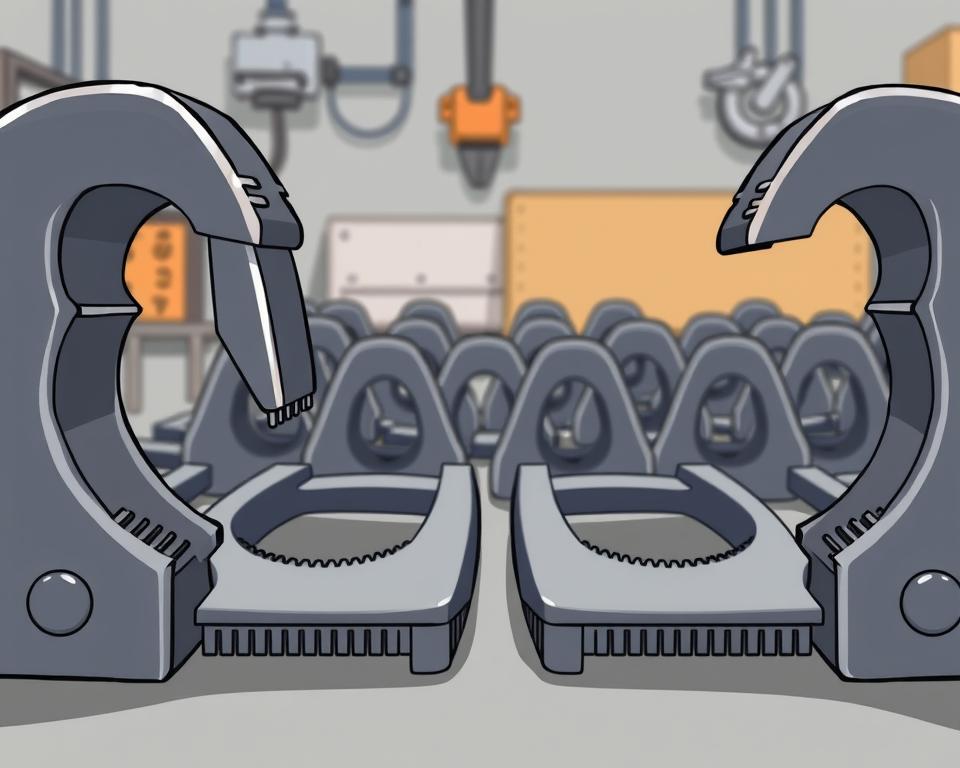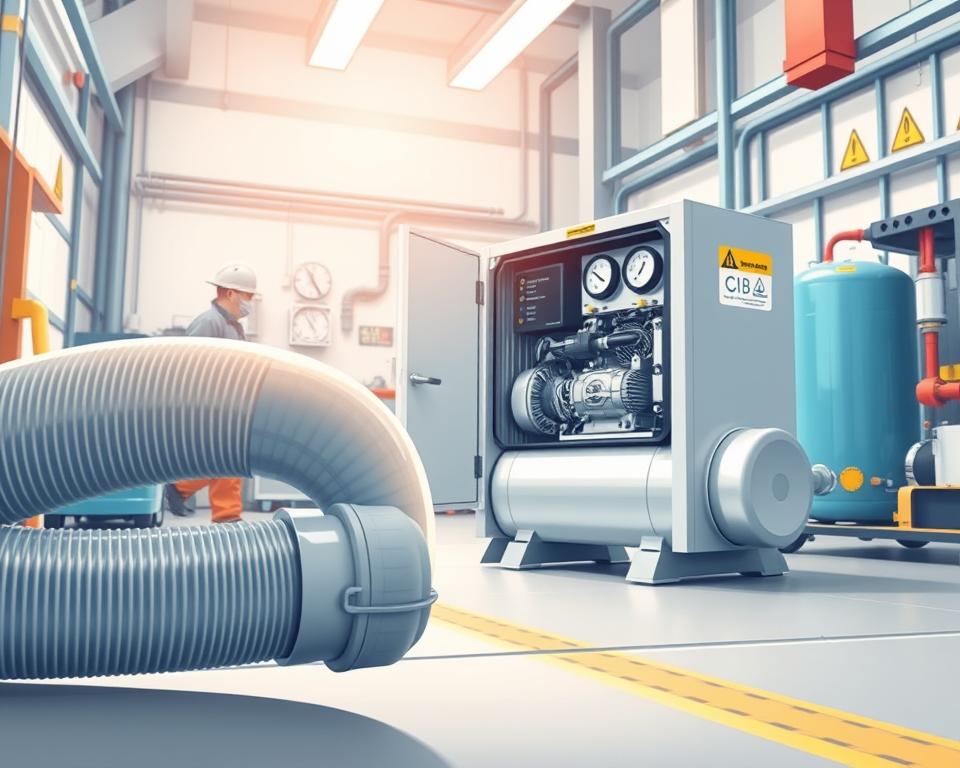Leading Selvage Jean Textile Manufacturers Guide
Did you know that self-edge denim, known for its robustness and everlasting allure, is made by talented craftsmen? The process of selvedge denim commences with the material makers who precisely weave and construct this iconic denim fabric. Finding the ideal selvedge denim fabric manufacturers is crucial to ensuring the superior craftsmanship and skill in your denim jeans.
If you’re on the hunt for the best self-edge denim, look no further. In this thorough handbook, we’ll lead you through the top selvedge denim fabric manufacturers, revealing the brands that are famous for their commitment to superiority and precision. From Iron Heart and Samurai to PBJ and Oldblue Co., we’ll delve into the top names that epitomize the spirit of selvedge denim fabric.
But first, let’s uncover the fundamentals of selvedge denim and grasp why it has entranced jean lovers and fashion aficionados alike. Explore the skill, legacy, and special characteristics that make Japanese-made, American, and European-made selvedge denim extraordinary. From the weaving process to the assorted weights and qualities, we’ll unravel the self-edge spectrum and give you the information to choose wisely.
So, whether you’re a jean expert or starting your journey into the world of self-edge denim, this guide will be your dependable resource in discovering the top selvedge denim fabric manufacturers and uncovering the core of this classic material. Let’s begin this denim journey together and discover the finest that self-edge denim has to offer.
Selvedge Denim Essentials: Grasping the Fundamentals
Self-edge denim is a pillar of excellent craftsmanship and everlasting appeal. But what exactly is self-edge denim, and what makes it unique from its other types? In this part, we will delve into the fundamentals of selvedge denim, explaining its special characteristics and why it has attracted such a dedicated audience.
Selvedge denim is a variety of jean material woven on vintage shuttle weaving machines, which make a finished edge on either side of the fabric. This sealed edge, characterized by the unique colored lines running along the outside of the border, prevents fraying edges and unraveling, resulting in a tidier, longer-lasting material. This meticulous focus on detail in the knitting method makes selvedge denim in high demand by jean lovers.
One of the defining features of selvedge denim is its association with top-tier quality and heavier weight fabric. Manufacturers, particularly those in Japanese, are renowned for their mastery of selvedge denim production, employing long-threaded cotton fibers and age-old practices to produce jeans that is not only long-lasting but also holds a rich texture and character depth.
Understanding self-edge denim basics is crucial to recognizing the distinctiveness of this material. The next part will explore the iconic Japanese mills famous for creating some of the finest self-edge denim in the globe.
Heritage and Craftsmanship: Exploring Japanese Selvage
This segment delves into the deep legacy and unmatched artistry behind Japanese selvedge denim. Japanese has long been associated with superior denim production, and its weaving factories have gained legendary status in the field. Let’s discover some of these renowned mills and find out the special characteristics that make Japanese-made denim remarkable.
Iconic Japanese Textile Mills
Japanese selvedge denim attributes its renown for superior craftsmanship to the knowledge and dedication of its weaving factories. Some of the most revered names in the market are:
| Textile Mill | Location |
|---|---|
| Amhot Textile Mill | Okayama Region |
| Kuroki Weaving Factory | Yamagata Region |
| Japan Blue/Collect Textile Mill | Kojima Region |
| Kaihara Weaving Factory | Hiroshima Prefecture |
| Nihon Menpu Mills | Tokyo City |
| Toyoshima Textile Mill | Chiba Region |
These mills have made themselves as trailblazers in creating some of the finest selvedge denim in the market. Each mill brings its distinctive style and skill to the denim creation process, resulting in a diverse range of options for denim fans.
Special Characteristics of Japanese Selvage
Japanese selvedge denim is esteemed for its outstanding craftsmanship and special features. Here are some of the main traits that set Japanese-made denim stand out:
- Premium Quality: Japanese mills are very proud of employing the superior materials and utilizing age-old practices to create denim with unequalled strength and comfort.
- Heavier Weight Fabric: Japanese-made denim is typically produced using heavier weight fabrics, renowned for their robustness and potential to generate beautiful fades over time.
- Reputation for Excellence: Japanese denim is generally considered as the epitome of premium denim fabric, desired by jean experts around the globe.
These special characteristics make Japanese self-edge denim a top choice among denim enthusiasts and aficionados who recognize the skill and craftsmanship that goes into creating each pair of jeans.
Learning about American Selvage: Iconic Mills and Their Histories
When it comes to American selvedge denim, there are a few famed weaving factories that have made a significant impact on the industry. One of the most recognizable is Cone Textile Mill, which holds the distinction as being the last self-edge denim factory in the United States.
Cone Textile Mill has a storied past, tracing its roots to 1891, and its association with Levi’s Jeans has been important in the acceptance of US-made denim. The high-quality fabric made by Cone Mills has been employed in Levi’s jeans for generations, making it synonymous with American denim heritage.
Aside from Cone Mills, there are other renowned American rainbow selvedge denim weaving factories that have added to the field development and renown. The White Oak Division, a division of Cone Textile Mill, was renowned for its superior material before its ending in 2017. Another famed factory is Rogue Territory, which has become known for its artistry and dedication to creating superior jeans.
Selecting high-quality self-edge denim from these American mills gives numerous advantages. The durability of the material secures that your denim wear will resist extended wear and many washes. Additionally, the one-of-a-kind color changes that appear with age create a personalized and distinctive look, making each jean pair truly one-of-a-kind. With American self-edge denim, you obtain excellent value for your money.
| Textile Mills | Established | Key Achievements |
|---|---|---|
| Cone Mills | the year 1891 | Provider of material for Levi’s |
| White Oak Branch (Cone Textile Mill) | 1905 | Famous for superior fabric before 2017 shutdown |
| Rogue Territory | 2008 | Recognized for craftsmanship and high-quality denim |
Uncovering European Expertise in Denim Production
European self-edge denim is famous for its exceptional craftsmanship and quality. In this segment, we highlight two Italian experts of denim creation: Candiani Textile Mill and Berto Weaving Factory. These mills have created a firm standing in the industry for their top-tier jean material.
Italian Experts: Candiani and Berto Mills
Candiani Mills, located in Italy, has been producing some of the best denim fabric since 1938. With a dedication to environmental responsibility, Candiani Mills utilizes advanced techniques and sustainable methods to create superior denim that meets the top standards.
- Their textiles are renowned for their gentleness, toughness, and exquisite color variations.
- Candiani’s European selvage is favored by style-leading brands and discerning denim enthusiasts alike.
- They have a diverse selection of denim options, from lightweight to thick, allowing for versatility in various apparel designs.
Berto Weaving Factory, another famed Italian textile mill, has been at the leading edge of denim creation for over 120 years. With a profound tradition and commitment to traditional craftsmanship, Berto Textile Mill keeps to deliver exceptional denim fabric that aligns with the top requirements.
- The European self-edge denim from Berto is known for its distinct character, with textured thickness and gorgeous wear patterns.
- Berto Textile Mill has a diverse range of denim types and surface treatments, enabling designers and denim fans to create distinctive and one-of-a-kind items.
- They value sustainable manufacturing practices and use organic and recycled materials to lessen the environmental impact of denim production.
Contributions from Cone Mills: America’s Denim Legacy
While uncovering European expertise, it’s vital to recognize the achievements of Cone Textile Mill, an famed American textile mill, to European textile heritage. Cone Mills has been a trailblazer in the jean market for more than a hundred years, renowned for its dedication to superiority and originality.
- Cone Mills’ selvage material have been utilized by famous jean labels around the globe, showcasing the versatility and toughness of American denim.
- The self-edge varieties from Cone Mills cover a wide range of types, thicknesses, and finishes, catering to the varied demands of fashion designers and denim fans.
- From traditional indigo denim to new elastic versions, Cone Textile Mill keeps to push the boundaries of denim creation.
Fans of European self-edge denim are are overwhelmed with choices with the superior selections from Candiani Textile Mill, Berto Weaving Factory, and the history of Cone Mills. These weaving factories symbolize the pinnacle of skill and demonstrate the commitment to excellence that has made European selvage material highly sought after in the style market.
The Self-edge Denim Textile Producers
In the universe of selvedge denim, a wide range of makers contribute to the production of this superior material. Each manufacturer brings its distinctive craftsmanship, resulting in a wide array of selvedge denim brands. Exploring various producers is vital in discovering the ideal pair of self-edge jeans that match personal tastes.
Below is a detailed roster of selvage material makers famous for their exceptional quality and skill:
| Producer |
|---|
| Iron Heart |
| Samurai Jeans |
| Oni Denim |
| PBJ |
| The Flat Head |
| Fullcount Denim |
| Benzak |
| Indigofera Prima Jeans |
| Blaumann Jeanshosen |
| Ooe Yofukuten & Co. |
| Oldblue Co. |
These makers have established themselves as leaders in the self-edge denim market. Each name has its individual flair, shape, and fabric composition, catering to different needs.
Whether you’re a die-hard denim enthusiast or a trendsetting individual, it’s important to discover the choices from different self-edge textile producers to discover the perfect pair of denim that resonate with your unique look.
The Craft of Denim Knitting: The Making of Self-edge
Jean knitting is a careful artistry that plays a pivotal role in the making of selvedge fabric. The complex knitting method includes the interweaving of yarns to create the distinctive slanting design that jeans is recognized by.
Vintage Looms Compared to Modern Machines
Two varieties of textile makers are commonly used in denim weaving: shuttle looms and high-speed looms. Loom shuttles are traditional, less fast devices that make selvage. These weaving machines have a loom carriage that carries the cross thread through the vertical yarns. The resulting fabric has a finished border, called the selvage, which prevents fraying and highlights the craftsmanship of the fabrication technique.
On the other hand, projectile looms are modern, fast instruments that are mostly used in mass production. These weaving machines shoot the weft thread across the lengthwise fibers using a sword-like device or aerodynamic system. While high-speed looms are efficient for high-volume denim fabrication, they do not produce raw denim material owing to their lack of closed-edge creation.
The Importance of Unwashed Denim in Self-edge Making
Unwashed denim, also known as natural or uncleaned denim, is essential in the making of self-edge textile. Untreated denim is made from cotton fibers that have not experienced any initial cleaning or processes, keeping the innate qualities of the fabric.
When untreated denim is crafted on shuttle weaving machines, it creates a robust and heavy textile with a tighter weave. The lack of pre-treatment enables the denim to form distinct wear patterns and wrinkles as they age, resulting in a individualized and distinctive look. This is why lovers of unwashed selvage value the superior and longevity of selvedge jeans.
The combination of shuttle looms and unwashed denim highlights the artisanal craftsmanship and focus on precision that goes into producing self-edge textile. Each self-edge jean pair tells a story through its woven construction and raw texture, making them a favorite among jean experts.
Exploring the Selvage Series: Types and Attributes
In the world of self-edge denim, classes and traits play a significant role in the distinctiveness of the fabric. Selvedge denim fabrics come in a diverse selection of weights, and each weight has its special features and advantages.
A common factor to think about when exploring selvage is the density of the textile. Selvage material classes can range, and heavier weights are commonly connected with durability and extended use. These fabrics have a closer interlacing and are less likely to deteriorate, making them perfect for those wanting a strong and long-lasting pair of jeans.
Alongside densities, selvage materials also has a range of attributes that enhance its desirability. One of these features is roughness, which refers to the varying density or thinness of the yarns used in the fabric. Rough selvage material has a bumpy and irregular surface, adding an aspect of distinctiveness and visual interest.
Feel is another important quality of self-edge textiles. Based on the weaving technique used and the kind of threads, selvedge denim can have a rough or even feel. The surface of the fabric influences the general appearance and touch of the denim, creating a unique touch sensation.
Wear pattern formation is another characteristic to take into account when discovering selvage materials. Specific varieties of selvedge denim are known for their outstanding color changes, permitting the material to show wear and develop one-of-a-kind looks with age. This feature adds to the individuality of self-edge textiles and the narrative it conveys through its appearance.
Overall, the selvage series encompasses a wide range of weights and qualities, allowing individuals to choose the fabric that best suits their needs and preferred feel. Whether wanting durability, feel, or fading potential, selvage materials has a wide array of options to discover.
Key Features to Consider When Choosing Selvedge Denim
When it comes to selecting the perfect pair of selvedge denim jeans, evaluating important traits can be crucial. Two key aspects to take into account are material thickness and toughness.
Fabric Weight and Durability
Material thickness decides the density and durability of the jeans, directly impacting its strength and wearability. Denser selvage denim, usually between 14 to 21 ounces, is typically stronger and resistant to wear and tear, making it an suitable selection for those looking for denim wear that can resist tough conditions and offer long-lasting quality.
The durability of self-edge jeans is increased by the dense knit of the material. The employment of traditional shuttle looms produces a closer interlacing, resulting in a stronger material that can endure frequent cleaning and regular wear.
For those who want a thinner choice, self-edge jeans with a lighter material thickness, ranging from 10 to 13 ounces, offers a more comfortable and cooler comfort. While less dense denim may not be as sturdy as denser selections, it still possesses a satisfactory strength and can develop unique fades and character with age.
Fade Potential and Textile Character
One of the main traits of self-edge jeans is its capacity to form distinct fades that reveal the wearer’s lifestyle and habits. Color changeability indicates the fabric’s tendency to wear in and form unique designs and hue changes with repeated wear and washing.
Material attributes is another key feature to take into account when picking selvedge denim. This indicates the unique aesthetic qualities, such as slubbiness, rope-like texture, and uneven knitting. These features contribute to the uniqueness of the fabric and can make each pair of jeans unique.
Whether you prefer a softer and even wear pattern or a dramatic and pronounced look, understanding the fade potential and textile character of selvage denim can guide you select a textile that matches your individual taste and desired look.
Fabric Weight and Durability
| Fabric Weight | Strength |
|---|---|
| Dense (14-21 oz) | Tough, perfect for hard wear |
| Thin (10-13 oz) | Tough enough with a softer wear |
Green Approaches in Selvage: Sustainable Creation Techniques
In the universe of selvedge denim, environmental responsibility has become an ever more important factor of sustainable creation. Consumers are now more conscious of the ecological footprint of the items they buy, and the denim industry is no different. To address these challenges, mills like Candiani have emerged as trailblazers of green selvage creation.
Candiani Mills, recognized as the most eco-friendly weaving factory in the market, is focused on employing green creation techniques. The textile maker prioritizes lowering water usage, reducing chemical use, and incorporating innovative technologies to achieve a eco-friendlier manufacturing approach. By employing these practices, Candiani Mills works to create denim material that more than aligns with superior benchmarks but also fits the principles of green-minded shoppers.
It is vital for consumers to choose wisely and endorse brands and manufacturers that value environmental responsibility. By choosing green selvage, shoppers can help with a eco-friendlier denim industry. Together, we can support the use of green methods throughout the manufacturing stages and promote a more sustainable future for denim manufacturing.
| Benefits of Sustainable Selvedge Denim |
|---|
| 1. Minimized water use |
| 2. Minimized chemical usage |
| 3. Minimized planetary burden |
| 4. Supports ethical manufacturing practices |
| 5. Matches eco-aware shopper principles |
Denim Innovations: Combining History with Innovation
This part of the piece explores the interesting universe of denim progress that smoothly merge heritage with contemporary techniques. Jeans, a timeless and beloved fabric, has kept changing to match the needs of modern style while holding fast to its roots.
Current Advancements in Denim Material
With progress in fabric techniques, denim producers have been able to enhance the performance and strength of their fabrics. Modern fabrication approaches, such as the utilization of loom shuttles, make a tighter, denser weave that produces a tougher and robust material. This not only extends the life of the textile but also contributes to top-tier color changes and unique texture.
Fabric treatments have also been important in boosting denim material. Unique methods, such as biological cleanings and surface treatments, can make a variety of finishes, from faded and aged appearances to refined and elegant designs. These treatments add versatility to classic jeans, making possible a broader selection of creative choices and shopper wants.
Advances in Eco-Friendly Practices
In addition to modern enhancements in denim material, the market has seen important innovations in environmental sustainability. Understanding the importance of minimizing its impact on the earth, denim producers have been investigating sustainable color applications and adopting the utilization of repurposed substances.
By employing eco-friendly color applications, such as foam dyeing or organic blue color, producers are reducing water and energy consumption while still producing vibrant and colorfast denim. The employment of reused substances, such as repurposed threads or plastic yarns, assists cut down on the need for new materials and diverts textile waste from landfills.
This dedication to environmental sustainability guarantees that denim creation can continue to thrive without harming the well-being of the earth. As the field progresses, employing both traditional craftsmanship and current advancements, a eco-friendlier and responsible method to denim manufacturing will become the standard.
Modern Enhancements and Environmental Sustainability in Denim
| Current Advancements | Eco-Friendly Practices |
|---|---|
| Cutting-edge knitting methods | Eco-friendly color applications |
| Textile techniques | Use of recycled materials |
The comparison above this text demonstrates the current advancements in denim material and the related advances in environmental sustainability. It highlights the persistent attempts of the field to merge tradition and innovation with eco-conscious practices, ensuring a more sustainable and more sustainable era for jeans.
Conclusion
After exploring the universe of selvedge denim fabric manufacturers, it is clear that there is a vast range of choices available to denim fans. From well-known names like Iron Heart, Samurai, and Oni Denim to The Flat Head, Full Count, and Indigofera Prima Jeans, each producer adds their individual flair and craftsmanship to the table. When it comes to selecting the ideal producer, it is vital to think about individual preferences and the desired look and feel of the denim.
In addition to the variety of producers, the benefits of premium raw selvedge denim cannot be overlooked. Its longevity, better fades, and great bang for your buck make it a worthwhile investment for jean enthusiasts. Moreover, sustainability is crucial in the denim field, and many makers are using green methods to production, such as Candiani Mills, renowned as the most eco-friendly weaving factory in the industry.
Lastly, the jean market persistently changes by blending tradition with technology. Contemporary improvements in denim material, such as advanced weaving techniques and material processes, improve the performance and toughness of self-edge jeans. Breakthroughs in environmental sustainability, such as green coloring methods and the utilization of repurposed substances, contribute to a more sustainable denim industry.
In final thoughts, exploring the universe of selvedge denim fabric manufacturers provides a variety of options and permits people to find the ideal pair of jeans that fit their personal tastes. From the perks of premium raw selvedge denim to green creation and denim progress, there is a lot to explore and appreciate in the realm of selvedge denim. So, make the effort to learn about and make informed choices to appreciate the classic look and excellence of selvage denim.



